Effect of Magnesium Chloride Solution as an Antifreeze Agent in Clay Stabilization during Freeze-Thaw Cycles
Abstract
:1. Introduction
2. Materials and Methods
2.1. Materials
2.1.1. Soil
2.1.2. Magnesium Chloride
2.2. Sample Preparation
2.3. Conducted Tests
3. Test Results and Discussion
3.1. Atterberg Limits Tests
3.2. Compaction Tests
3.3. Unconfined Compression Tests
3.4. Freeze-Thaw Cycles Tests
3.4.1. Results at −10 °C
3.4.2. Results at −20 °C
3.5. Effect of Freeze-Thaw Cycles on Soil Volume Alterations
3.6. Microstructural Analyses
3.6.1. XRD & FTIR Analysis
3.6.2. SEM Analysis
4. Conclusions
Author Contributions
Funding
Institutional Review Board Statement
Informed Consent Statement
Data Availability Statement
Acknowledgments
Conflicts of Interest
References
- Sebt, M.H.; Rajaei, H.; Pakseresht, M.M. A Fuzzy Modeling Approach to Weather Delays Analysis in Construction Projects. Int. J. Civ. Eng. 2007, 5, 169–181. [Google Scholar]
- Alshebani, M.; Wedawatta, G. Making the Construction Industry Resilient to Extreme Weather: Lessons from Construction in Hot Weather Conditions. Procedia Econ. Financ. 2014, 18, 635–642. [Google Scholar] [CrossRef]
- Senouci, A.B.; Mubarak, S.A. Multiobjective optimization model for scheduling of construction projects under extreme weather. J. Civ. Eng. Manag. 2016, 22, 373–381. [Google Scholar] [CrossRef]
- Effect of Weather on Highway Construction, in NCHRP Synthesis 20-05/Topic 05-07; National Cooperative Highway Research Program: Washington, DC, USA, 1978.
- Daniels, J.L.; Janardhanam, R.; Anderson, J.B.; Lei, S.; Baucom, I.K.; DeBlasis, N.J.; Bowers, B.F. Subgrade Stabilization Alternatives to Lime and Cement Final Report FHWA/NC/2007-11; North Carolina Department of Transportation: Raleigh, NC, USA, 2010.
- Ma, Q.; Zhang, K.; Jabro, J.D.; Ren, L.; Liu, H. Freeze–thaw cycles effects on soil physical properties under different degraded conditions in Northeast China. Environ. Earth Sci. 2019, 78, 321. [Google Scholar] [CrossRef]
- Zhang, A.; Zhang, J.; Peng, J.; Huang, C.; Zhou, C. Effect of Freeze-Thaw Cycles on Mechanical Properties of an Embankment Clay: Laboratory Tests and Model Evaluations. Front. Earth Sci. 2022, 10, 865348. [Google Scholar] [CrossRef]
- Six, J.; Bossuyt, H.; Degryze, S.; Denef, K. A history of research on the link between (micro)aggregates, soil biota, and soil organic matter dynamics. Soil Tillage Res. 2004, 79, 7–31. [Google Scholar] [CrossRef]
- Kværnø, S.H.; Øygarden, L. The influence of freeze–thaw cycles and soil moisture on aggregate stability of three soils in Norway. Catena 2006, 67, 175–182. [Google Scholar] [CrossRef]
- Logsdail, D.E.; Webber, L.R. Effect Of Frost Action On Structure Of Haldimand Clay. Can. J. Soil Sci. 1959, 39, 103–106. [Google Scholar] [CrossRef]
- Cruse, R.M.; Mier, R.; Mize, C.W. Surface Residue Effects on Erosion of Thawing Soils. Soil Sci. Soc. Am. J. 2001, 65, 178–184. [Google Scholar] [CrossRef]
- Xu, J.; Ren, J.; Wang, Z.; Wang, S.; Yuan, J. Strength behaviors and meso-structural characters of loess after freeze-thaw. Cold Reg. Sci. Technol. 2018, 148, 104–120. [Google Scholar] [CrossRef]
- Dalla Santa, G.; Cola, S.; Secco, M.; Tateo, F.; Sassi, R.; Galgaro, A. Multiscale analysis of freeze–thaw effects induced by ground heat exchangers on permeability of silty clays. Géotechnique 2019, 69, 95–105. [Google Scholar] [CrossRef]
- Viklander, P. Permeability and volume changes in till due to cyclic freeze/thaw. Can. Geotech. J. 1998, 35, 471–477. [Google Scholar] [CrossRef]
- Qi, J.; Ma, W.; Song, C. Influence of freeze–thaw on engineering properties of a silty soil. Cold Reg. Sci. Technol. 2008, 53, 397–404. [Google Scholar] [CrossRef]
- Miao, Q.; Niu, F.; Lin, Z.; Luo, J.; Liu, M. Comparing frost heave characteristics in cut and embankment sections along a high-speed railway in seasonally frozen ground of Northeast China. Cold Reg. Sci. Technol. 2020, 170, 102921. [Google Scholar] [CrossRef]
- Wang, T.-L.; Liu, Y.-J.; Yan, H.; Xu, L. An experimental study on the mechanical properties of silty soils under repeated freeze–thaw cycles. Cold Reg. Sci. Technol. 2015, 112, 51–65. [Google Scholar] [CrossRef]
- Li, G.; Yu, Q.; Ma, W.; Chen, Z.; Mu, Y.; Guo, L.; Wang, F. Freeze–thaw properties and long-term thermal stability of the unprotected tower foundation soils in permafrost regions along the Qinghai–Tibet Power Transmission Line. Cold Reg. Sci. Technol. 2016, 121, 258–274. [Google Scholar] [CrossRef]
- Gowthaman, S.; Nakashima, K.; Kawasaki, S. Freeze-thaw durability and shear responses of cemented slope soil treated by microbial induced carbonate precipitation. Soils Found. 2020, 60, 840–855. [Google Scholar] [CrossRef]
- Kamei, T.; Ahmed, A.; Shibi, T. Effect of freeze–thaw cycles on durability and strength of very soft clay soil stabilised with recycled Bassanite. Cold Reg. Sci. Technol. 2012, 82, 124–129. [Google Scholar] [CrossRef]
- Lu, Y.; Liu, S.; Alonso, E.; Wang, L.; Xu, L.; Li, Z. Volume changes and mechanical degradation of a compacted expansive soil under freeze-thaw cycles. Cold Reg. Sci. Technol. 2019, 157, 206–214. [Google Scholar] [CrossRef]
- Eigenbrod, K.D. Effects of cyclic freezing and thawing on volume changes and permeabilities of soft fine-gained soils. Can. Geotech. J. 1996, 33, 529–537. [Google Scholar] [CrossRef]
- Orakoglu, M.E.; Liu, J. Effect of freeze-thaw cycles on triaxial strength properties of fiber-reinforced clayey soil. KSCE J. Civ. Eng. 2017, 21, 2128–2140. [Google Scholar] [CrossRef]
- Lu, Y.; Liu, S.; Zhang, Y.; Li, Z.; Xu, L. Freeze-thaw performance of a cement-treated expansive soil. Cold Reg. Sci. Technol. 2020, 170, 102926. [Google Scholar] [CrossRef]
- Yıldız, M.; Soğancı, A.S. Effect of freezing and thawing on strength and permeability of lime-stabilized clays. Sci. Iran. 2012, 19, 1013–1017. [Google Scholar] [CrossRef]
- Nguyen, T.T.H.; Cui, Y.-J.; Ferber, V.; Herrier, G.; Ozturk, T.; Plier, F.; Puiatti, D.; Salager, S.; Tang, A.M. Effect of freeze-thaw cycles on mechanical strength of lime-treated fine-grained soils. Transp. Geotech. 2019, 21, 100281. [Google Scholar] [CrossRef]
- Dayioglu, M.; Cetin, B.; Nam, S. Stabilization of expansive Belle Fourche shale clay with different chemical additives. Appl. Clay Sci. 2017, 146, 56–69. [Google Scholar] [CrossRef]
- Miraki, H.; Shariatmadari, N.; Ghadir, P.; Jahandari, S.; Tao, Z.; Siddique, R. Clayey soil stabilization using alkali-activated volcanic ash and slag. J. Rock Mech. Geotech. Eng. 2022, 14, 576–591. [Google Scholar] [CrossRef]
- Bonal, N.S.; Prasad, A.; Verma, A.K. Effect of Thermogelation Biopolymers on Geotechnical Properties of Red Mud Tailings Exposed to Freeze and Thaw. J. Cold Reg. Eng. 2022, 36, 04022004. [Google Scholar] [CrossRef]
- Chen, Y.; Huang, Y.; Wang, S.; Mu, Y. Effects of Phase Change Materials on the Freeze–Thaw Performance of Expansive Soil. J. Mater. Civ. Eng. 2023, 35, 04023206. [Google Scholar] [CrossRef]
- Tiwari, N.; Satyam, N.; Puppala, A.J. Strength and durability assessment of expansive soil stabilized with recycled ash and natural fibers. Transp. Geotech. 2021, 29, 100556. [Google Scholar] [CrossRef]
- Tao, Z.; Zhang, Y.; Chen, X.; Gu, X. Effects of freeze-thaw cycles on the mechanical properties of cement-fiber composite treated silty clay. Constr. Build. Mater. 2022, 316, 125867. [Google Scholar] [CrossRef]
- Soltani-Jigheh, H.; Bagheri, M.; Amani-Ghadim, A.R. Use of hydrophilic polymeric stabilizer to improve strength and durability of fine-grained soils. Cold Reg. Sci. Technol. 2019, 157, 187–195. [Google Scholar] [CrossRef]
- Bandara, N.; Binoy, T.H.; Aboujrad, H.S. Freeze-Thaw Durability of Subgrades Stabilized with Recycled Materials. Cold Reg. Eng. 2015, 135–145. [Google Scholar] [CrossRef]
- Li, B.; Luo, F.; Li, X.; Liu, J. Mechanical properties evolution of clays treated with rice husk ash subjected to freezing-thawing cycles. Case Stud. Constr. Mater. 2024, 20, e02712. [Google Scholar] [CrossRef]
- Dye, R.F. Ethylene glycols technology. Korean J. Chem. Eng. 2001, 18, 571–579. [Google Scholar] [CrossRef]
- Yue, H.; Zhao, Y.; Ma, X.; Gong, J. Ethylene glycol: Properties, synthesis, and applications. Chem. Soc. Rev. 2012, 41, 4218–4244. [Google Scholar] [CrossRef] [PubMed]
- Akram, J.; Akbar, N.S.; Tripathi, D. Comparative study on ethylene glycol based Ag-Al2O3 and Al2O3 nanofluids flow driven by electroosmotic and peristaltic pumping: A nano-coolant for radiators. Phys. Scr. 2020, 95, 115208. [Google Scholar] [CrossRef]
- Estabragh, A.R.; Khatibi, M.; Javadi, A.A. Effect of Cement on Mechanical Behavior of Soil Contaminated with Monoethylene Glycol (MEG). ACI Mater. J. 2016, 113. [Google Scholar] [CrossRef]
- Li, X.; Li, X. A soil freezing-thawing model based on thermodynamics. Cold Reg. Sci. Technol. 2023, 211, 103867. [Google Scholar] [CrossRef]
- Li, X.; Li, X.; Liu, J. A dynamic soil freezing characteristic curve model for frozen soil. J. Rock Mech. Geotech. Eng. 2023; in press. [Google Scholar] [CrossRef]
- Turkoz, M.; Savas, H.; Acaz, A.; Tosun, H. The effect of magnesium chloride solution on the engineering properties of clay soil with expansive and dispersive characteristics. Appl. Clay Sci. 2014, 101, 1–9. [Google Scholar] [CrossRef]
- Muhammad, N.; Siddiqua, S.; Latifi, N. Solidification of Subgrade Materials Using Magnesium Alkalinization: A Sustainable Additive for Construction. J. Mater. Civ. Eng. 2018, 30, 04018260. [Google Scholar] [CrossRef]
- Bahloul, O.; Abbeche, K.; Bahloul, A. Microstructure and geotechnical characteristics of a highly plastic clay treated by magnesium chloride. Min. Sci. 2019, 26, 249–262. [Google Scholar] [CrossRef]
- Tang, Y.; Wang, N.; Xu, F.; Teng, D.; Cui, X. Electrokinetic stabilization of marine clayey soil using magnesium chloride solution: A green soil stabilizer. Mar. Georesources Geotechnol. 2021, 40, 248–254. [Google Scholar] [CrossRef]
- ASTM D7928-21e1; Standard Test Method for Particle-Size Distribution (Gradation) of Fine-Grained Soils Using the Sedimentation (Hydrometer) Analysis. ASTM International: West Conshohocken, PA, USA, 2021.
- ASTM D4318-17e1; Standard Test Methods for Liquid Limit, Plastic Limit, and Plasticity Index of Soils. ASTM International: West Conshohocken, PA, USA, 2018.
- ASTM D854-23; Standard Test Methods for Specific Gravity of Soil Solids by the Water Displacement Method. ASTM International: West Conshohocken, PA, USA, 2023.
- ASTM D2487-17e1; Standard Practice for Classification of Soils for Engineering Purposes (Unified Soil Classification System). ASTM International: West Conshohocken, PA, USA, 2020.
- Frisman, P. Use of Magnesium Chloride During Snowstorms; Office of Legislative Research (OLR): Hartford, CT, USA, 2014.
- Ketcham, S.; Minsk, L.D.; Blackburn, R.R.; Fleege, E.J. Manual of Practice for An Effective Anti-Icing Program—A Guide for Highway Winter Maintenance Personnel; FHWA: Washington, DC, USA, 2006. [Google Scholar]
- ASTM D698-12(2021); Standard Test Methods for Laboratory Compaction Characteristics of Soil Using Standard Effort (12,400 ft-lbf/ft3 (600 kN-m/m3)). ASTM International: West Conshohocken, PA, USA, 2021.
- ASTM D2166/D2166M-16; Standard Test Method for Unconfined Compressive Strength of Cohesive Soil. ASTM International: West Conshohocken, PA, USA, 2016.
- ASTM D560/D560M-16; Standard Test Methods for Freezing and Thawing Compacted Soil-Cement Mixtures. ASTM International: West Conshohocken, PA, USA, 2016.
- Venkatabor Rad, G.; Rechi, T. Physico-chemical mechanism governing the plasticity behaviors of soils. J. Indian Geotech. 1977, 7, 261–282. [Google Scholar]
- Randolph, R.B. Earth Materials Catalyst Stabilization for Road Bases, Road Shoulders, Unpaved Roads, and Transportation Earthworks. Transp. Res. Rec. 1997, 1589, 58–63. [Google Scholar] [CrossRef]
- Shibi, T.; Kamei, T. Effect of freeze–thaw cycles on the strength and physical properties of cement-stabilised soil containing recycled bassanite and coal ash. Cold Reg. Sci. Technol. 2014, 106–107, 36–45. [Google Scholar] [CrossRef]
- Wang, D.-Y.; Ma, W.; Niu, Y.-H.; Chang, X.-X.; Wen, Z. Effects of cyclic freezing and thawing on mechanical properties of Qinghai–Tibet clay. Cold Reg. Sci. Technol. 2007, 48, 34–43. [Google Scholar] [CrossRef]
- Jamshidi, M.; Mokhberi, M.; Vakili, A.H.; Nasehi, A. Effect of chitosan bio-polymer stabilization on the mechanical and dynamic characteristics of marl soils. Transp. Geotech. 2023, 42, 101110. [Google Scholar] [CrossRef]

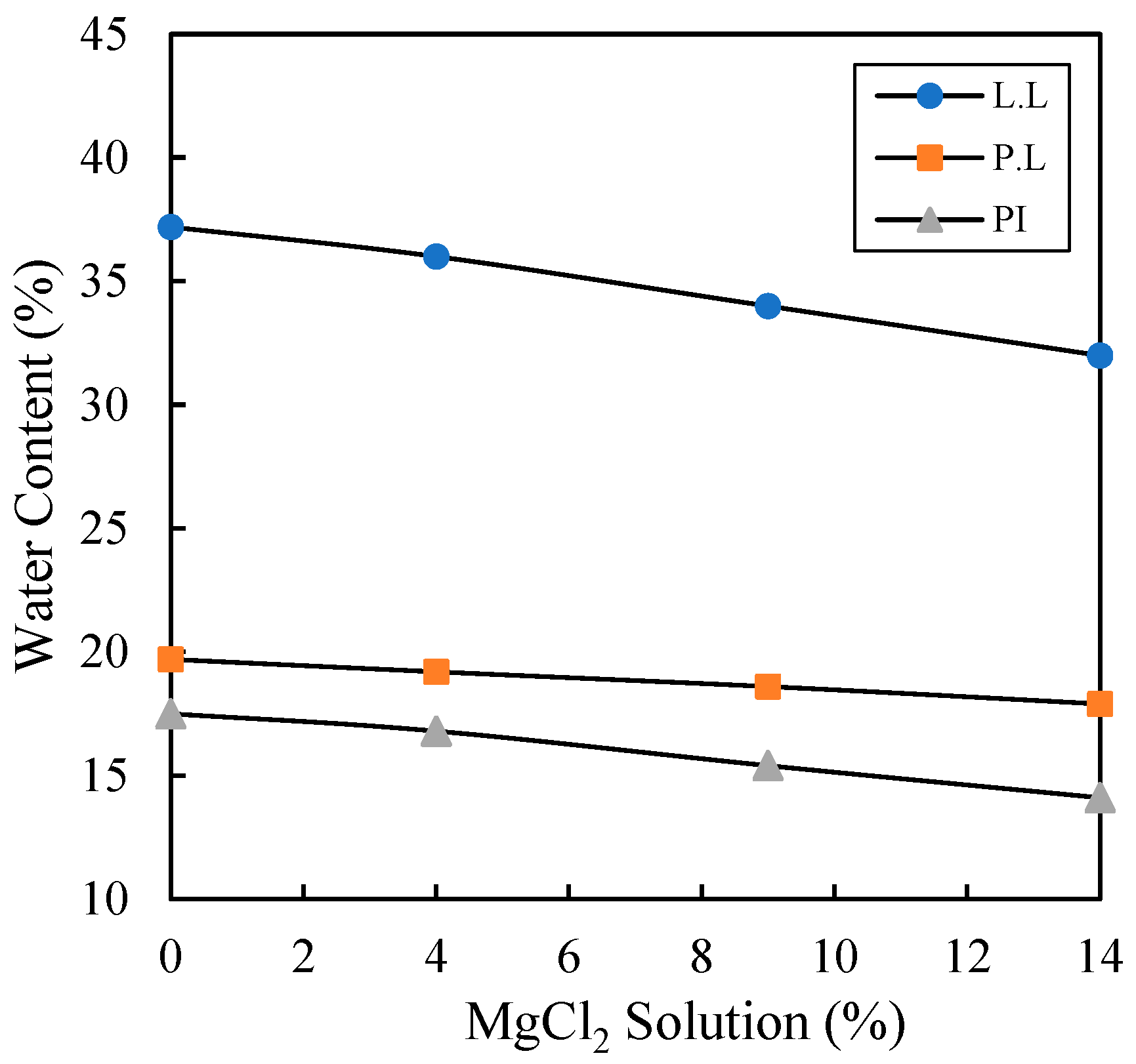
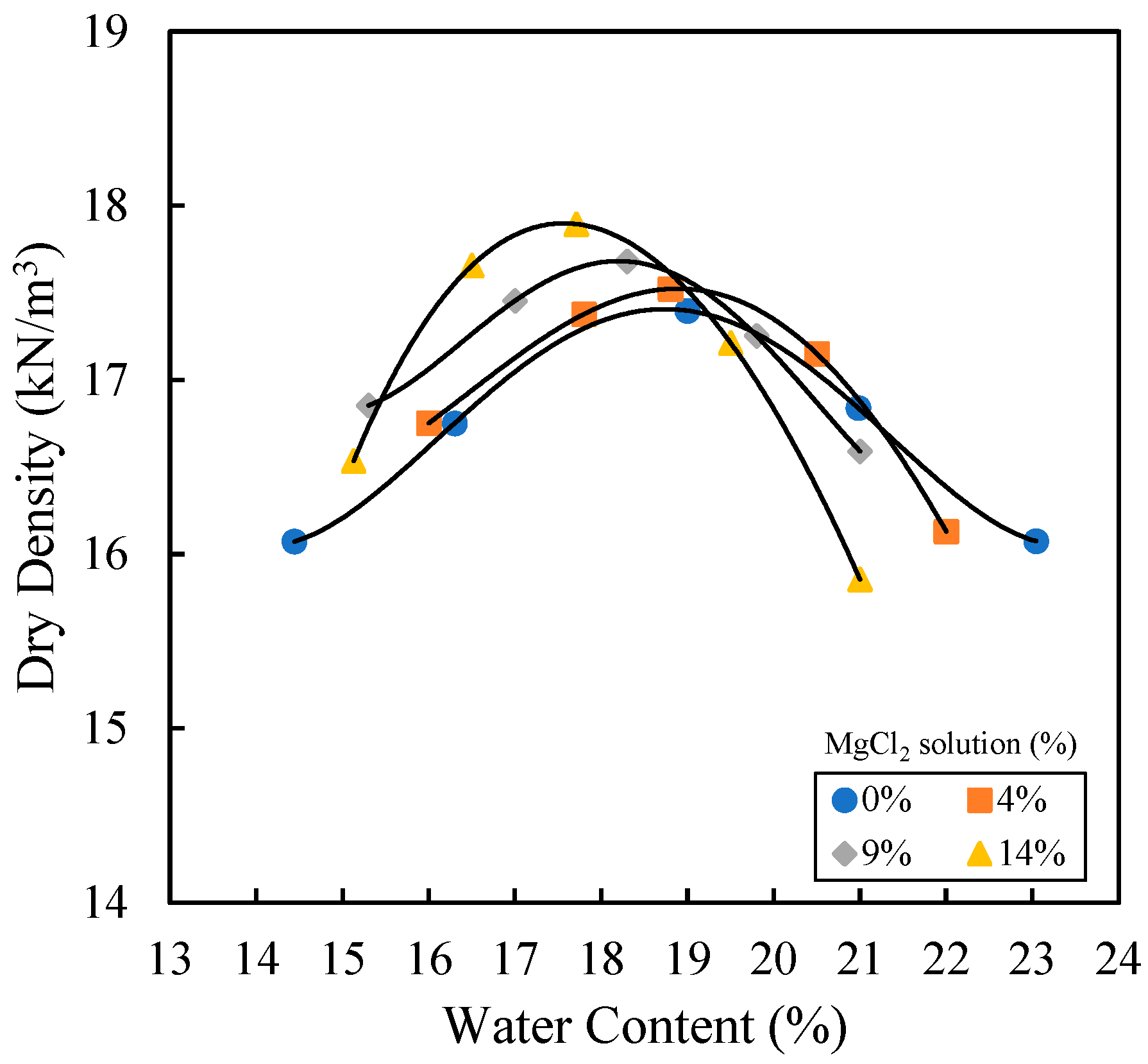



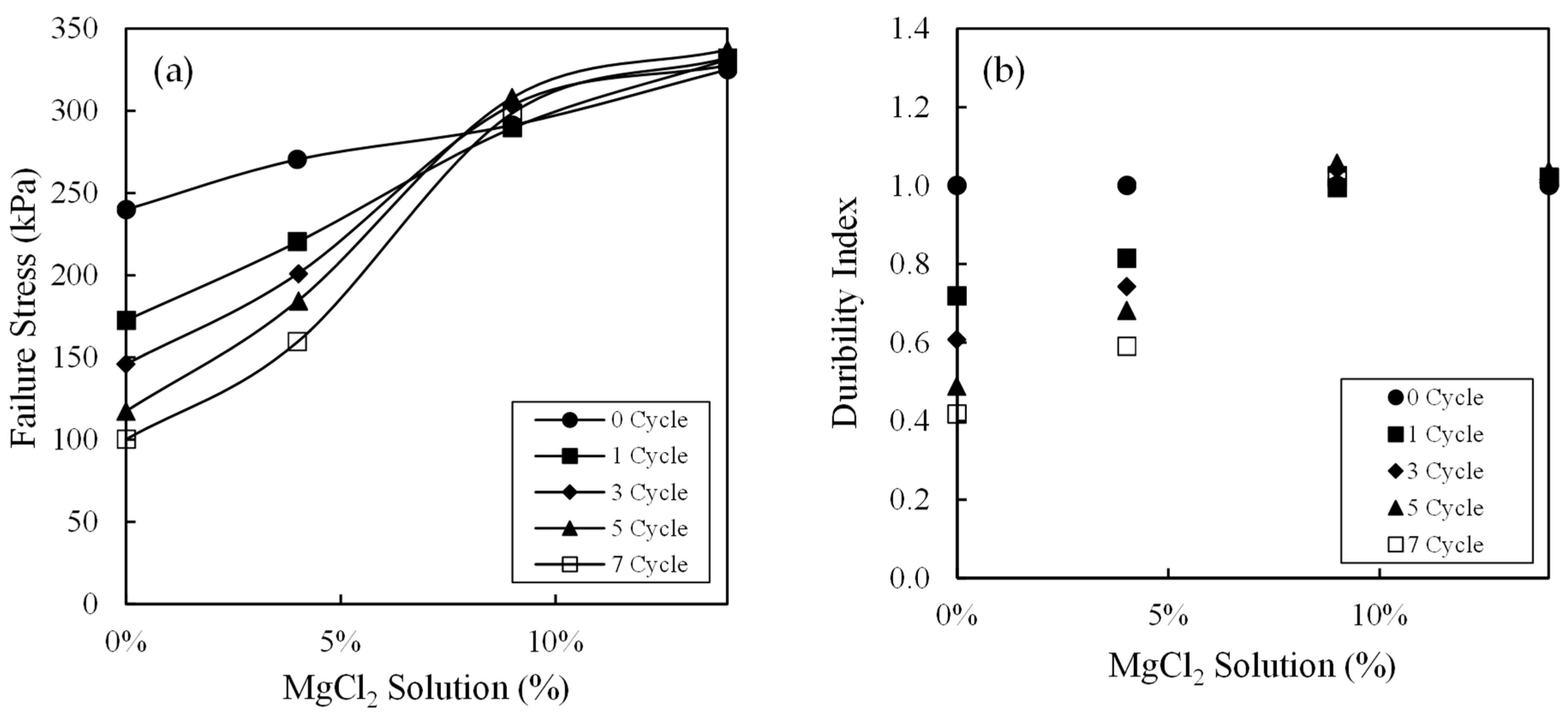
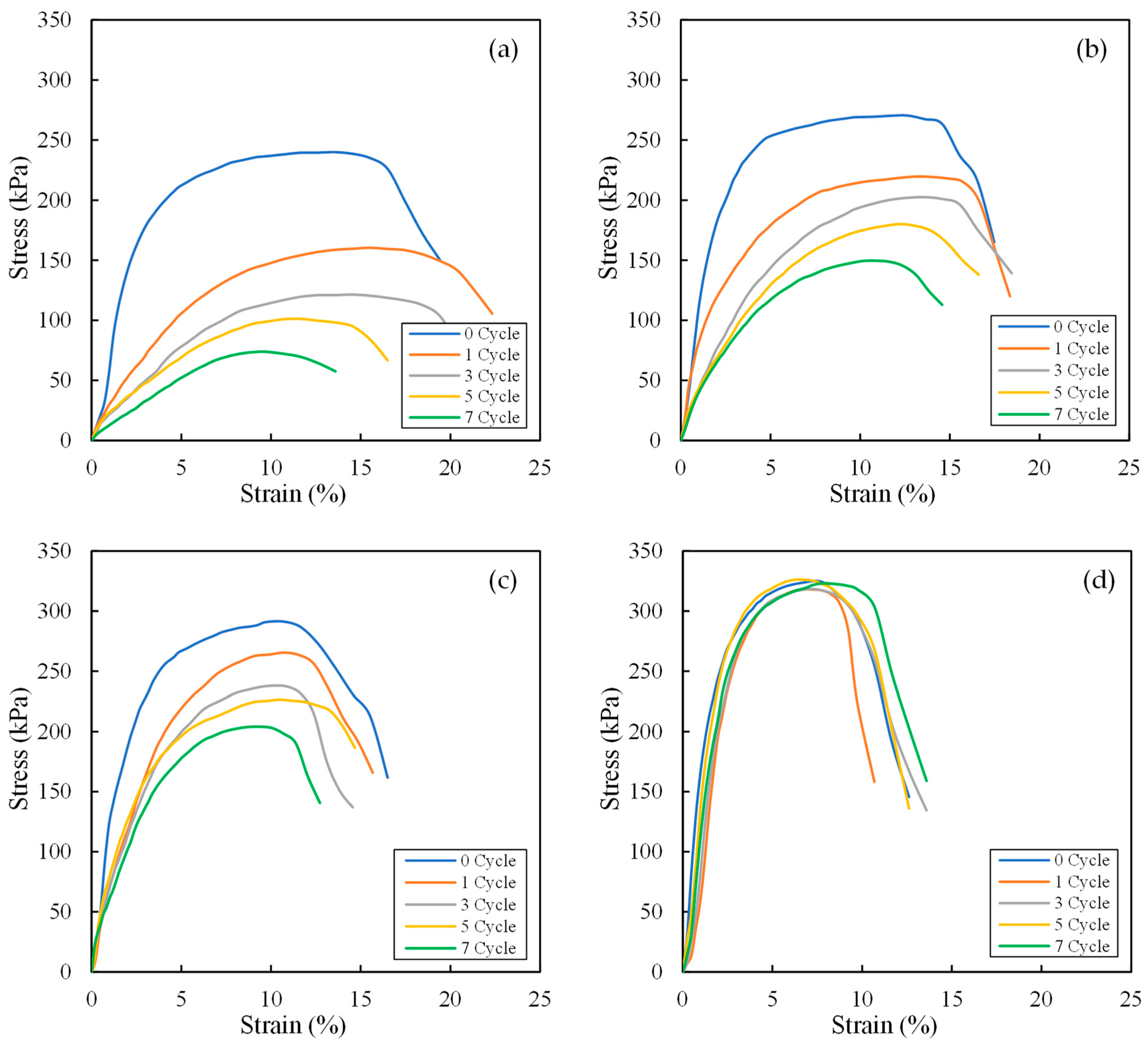
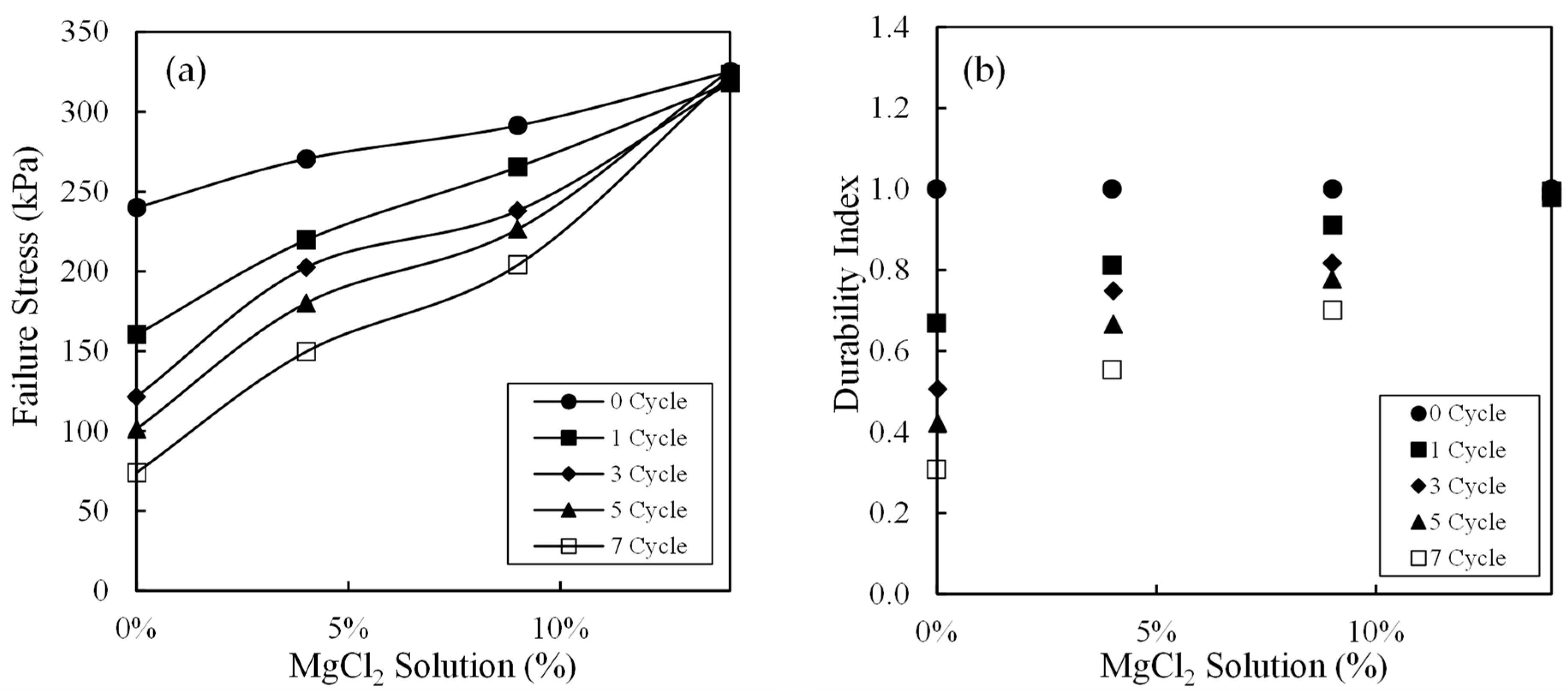
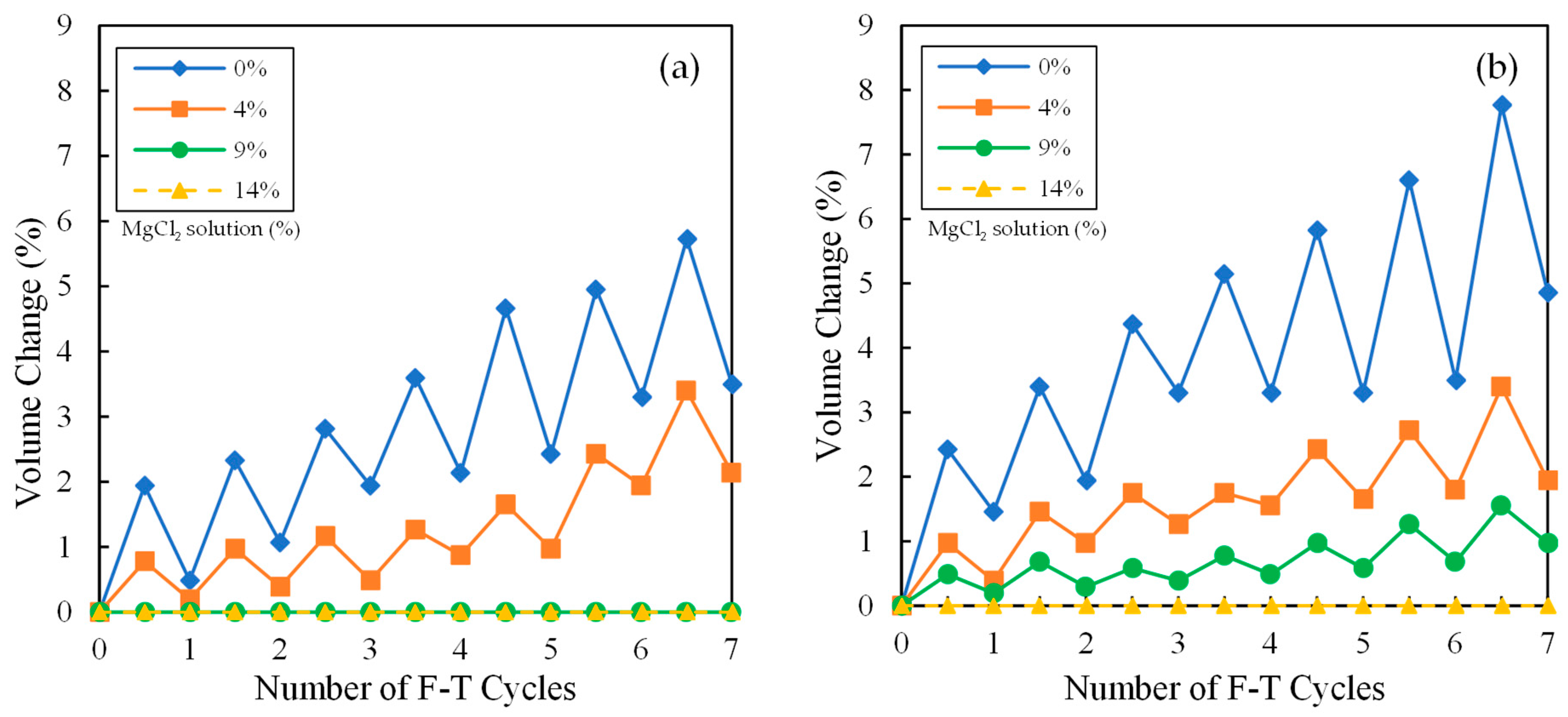
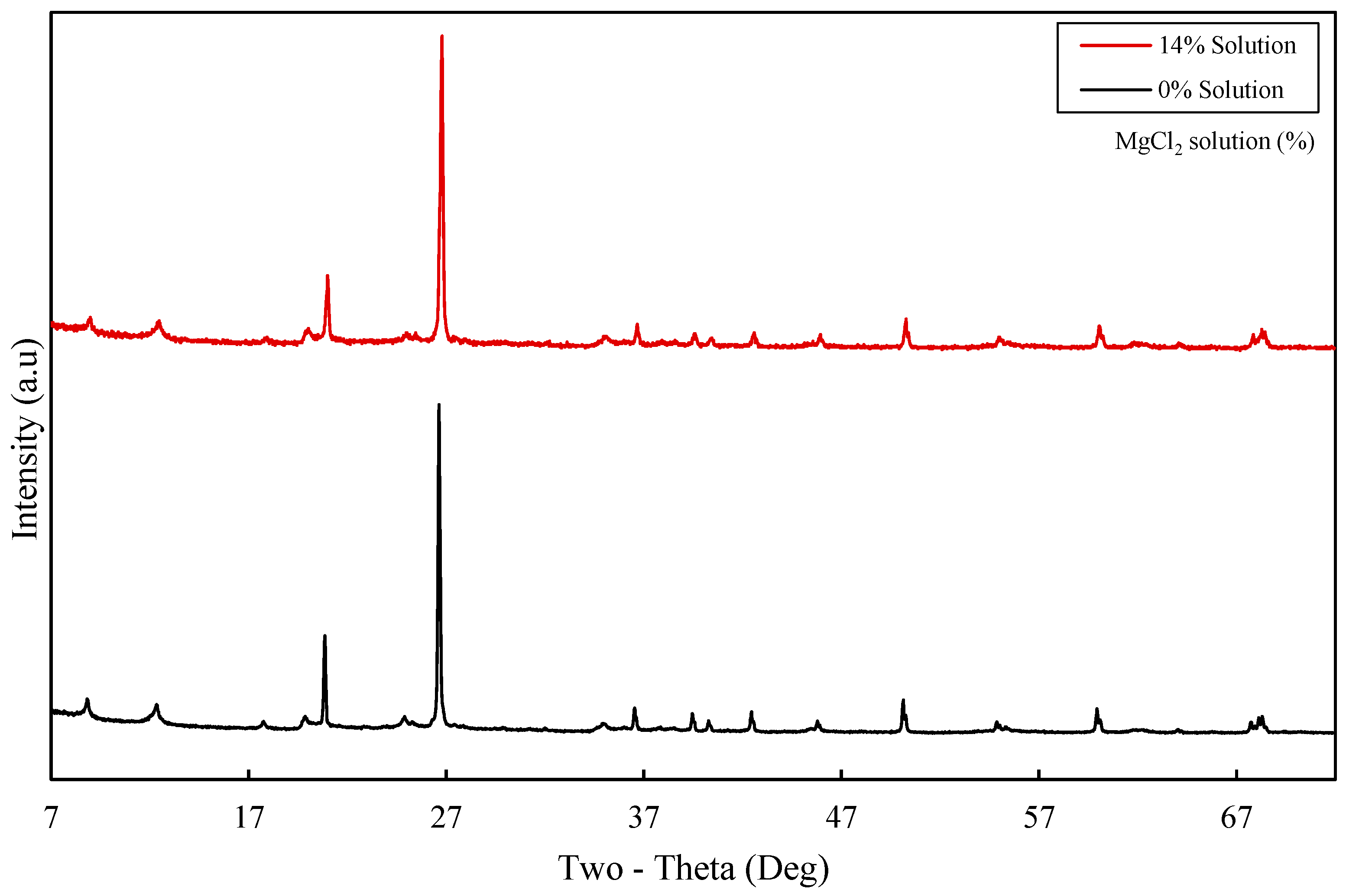

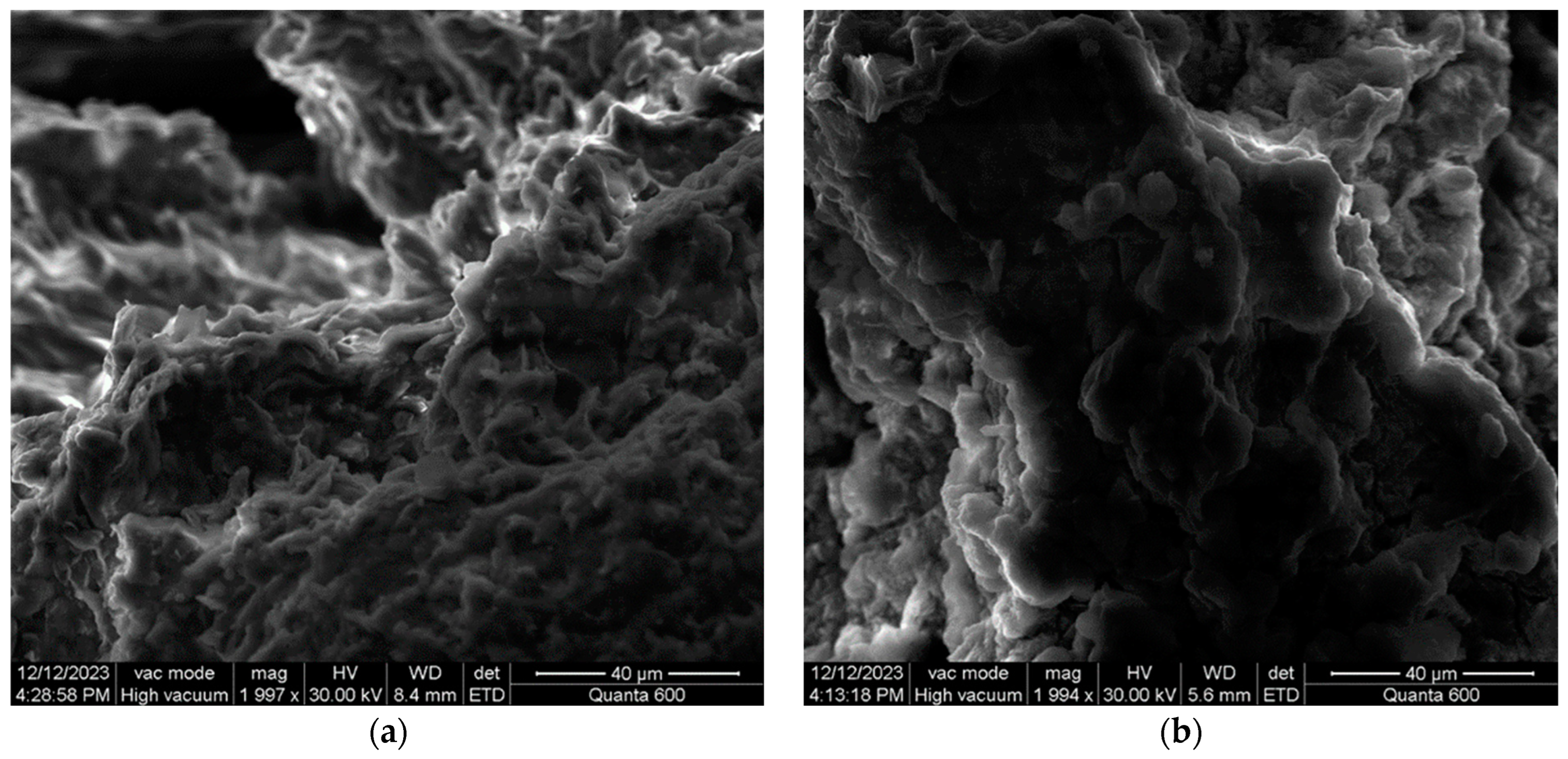
| Physical Properties | Values |
|---|---|
| Silt (%) | 61 |
| Clay (%) | 39 |
| Specific gravity | 2.72 |
| Maximum dry density (kN/m3) | 17.4 |
| Optimum water content (%) | 19 |
| Liquid limit (%) | 37.2 |
| Plastic limit (%) | 19.7 |
| Plasticity index (%) | 17.5 |
| pH | 8.1 |
| Constituents | Specification |
|---|---|
| Magnesium Chloride (MgCl2) | Min 46.5% |
| Calcium Chloride (CaCl2) | Max 2.2% |
| Sodium Chloride (NaCl) | Max 0.9% |
| Potassium Chloride (KCl) | Max 0.6% |
| Water of Crystallization | Balance to 100% |
| Sulfates (SO4) | Max 0.025% |
| Iron (Fe) | Max 5 ppm |
| Mercury (Hg) | Max 0.2 ppm |
| Lead (Pb) | Max 0.1 ppm |
| Arsenic (As) | Max 0.1 ppm |
| Cadmium (Cd) | Max 0.1 ppm |
| pH of aqueous Solution | 8.0–9.5 |
| MgCl2 Solution Concentration (%) | Optimum Water Content (%) | Maximum Dry Density (kN/m3) |
|---|---|---|
| 0% | 19 | 17.4 |
| 4% | 18.9 | 17.52 |
| 9% | 18.3 | 17.68 |
| 14% | 17.71 | 17.89 |
Disclaimer/Publisher’s Note: The statements, opinions and data contained in all publications are solely those of the individual author(s) and contributor(s) and not of MDPI and/or the editor(s). MDPI and/or the editor(s) disclaim responsibility for any injury to people or property resulting from any ideas, methods, instructions or products referred to in the content. |
© 2024 by the authors. Licensee MDPI, Basel, Switzerland. This article is an open access article distributed under the terms and conditions of the Creative Commons Attribution (CC BY) license (https://creativecommons.org/licenses/by/4.0/).
Share and Cite
Yeganeh Rikhtehgar, A.; Teymür, B. Effect of Magnesium Chloride Solution as an Antifreeze Agent in Clay Stabilization during Freeze-Thaw Cycles. Appl. Sci. 2024, 14, 4140. https://doi.org/10.3390/app14104140
Yeganeh Rikhtehgar A, Teymür B. Effect of Magnesium Chloride Solution as an Antifreeze Agent in Clay Stabilization during Freeze-Thaw Cycles. Applied Sciences. 2024; 14(10):4140. https://doi.org/10.3390/app14104140
Chicago/Turabian StyleYeganeh Rikhtehgar, Amin, and Berrak Teymür. 2024. "Effect of Magnesium Chloride Solution as an Antifreeze Agent in Clay Stabilization during Freeze-Thaw Cycles" Applied Sciences 14, no. 10: 4140. https://doi.org/10.3390/app14104140
APA StyleYeganeh Rikhtehgar, A., & Teymür, B. (2024). Effect of Magnesium Chloride Solution as an Antifreeze Agent in Clay Stabilization during Freeze-Thaw Cycles. Applied Sciences, 14(10), 4140. https://doi.org/10.3390/app14104140










